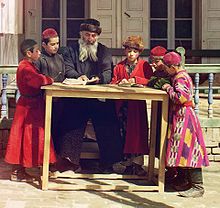History of the Jews in Uzbekistan

| Total population | |
|---|---|
| 9,865[1] | |
| Languages | |
| Bukhori, Uzbek, Russian, and Yiddish | |
| Religion | |
| Judaism | |
| Related ethnic groups | |
| Other Bukharan Jews Russian Jews, Ashkenazi Jews |
The history of the Jews in Uzbekistan refers to the history of two distinct communities; the more religious and traditional Bukharan Jewish community and the Ashkenazi community.
There were 94,900 Jews in Uzbekistan in 1989,[2] but fewer than 10,000 remained in 2021 (around 38% of which lived in Tashkent).[3]
There are 12 synagogues in Uzbekistan.[4]

Fergana Jewish community
[edit]Semyon Abdurakhmanov is the head of the Fergana Jewish community. There are six synagogues in the Valley. There are several hundred Jews in Fergana, Namangan, and Kokand, with about 1,300 total in the area. Abdurakhmanov has said that the biggest problem faced by the Jewish Uzbek community is the economy.
During the Andijan Massacre in May 2005, the Israeli Embassy in Tashkent asked Abdurakhmanov to make a lists of Jews "in case there will be a need to airlift people to Israel".[4]
Historical demographics
[edit]| Year | Pop. | ±% |
|---|---|---|
| 1926 | 37,896 | — |
| 1939 | 50,676 | +33.7% |
| 1959 | 94,488 | +86.5% |
| 1970 | 103,058 | +9.1% |
| 1979 | 100,067 | −2.9% |
| 1989 | 95,104 | −5.0% |
| 2021 | 9,865 | −89.6% |
Source:
| ||
The Jewish population of Uzbekistan (then known as the Uzbek SSR) nearly tripled between 1926 and 1970, then slowly declined between 1970 and 1989, followed by a much more rapid decline since 1989, when the collapse of Communism began. According to the Soviet census, there were 103,000 Jews in Uzbekistan in 1970.[8]
Between 1989 and 2021, around ninety percent of Uzbekistan's Jewish population left Uzbekistan and moved to other countries, mostly to Israel.[9]
In the 2021 census, there were almost 10,000 Jews in Uzbekistan, diffused over the country. Over 1,000 were in Bukhara, and almost 1,500 were in Samarkand; around 1,300 were in Fergana, and over 3,700 were in Tashkent. The remaining 2,300 were spread around the country in smaller numbers.[10]
See also
[edit]References
[edit]- ^ "Uzbek Census 2021". data.egov.uz.
- ^ World Jewish Population 2001 Archived 2013-12-06 at the Wayback Machine, American Jewish Yearbook, vol. 101 (2001), p. 561.
- ^ "Uzbek Census 2021". data.egov.uz.
- ^ a b Uzbek Jewish worries Archived 2013-01-04 at archive.today JTA
- ^ "Приложение Демоскопа Weekly". Demoscope.ru. 2013-01-15. Archived from the original on 2013-10-12. Retrieved 2013-04-14.
- ^ "Uzbek Census 2021". data.egov.uz.
- ^ "YIVO | Population and Migration: Population since World War I". Yivoencyclopedia.org. Retrieved 2013-04-14.
- ^ "The Jewish Community of Uzbekistan". The Museum of the Jewish People at Beit Hatfutsot. Archived from the original on 25 June 2018. Retrieved 25 June 2018.
- ^ "tab30.XLS" (PDF). Archived from the original (PDF) on 2014-07-14. Retrieved 2013-04-14.
- ^ "Uzbek Census 2021". data.egov.uz.
